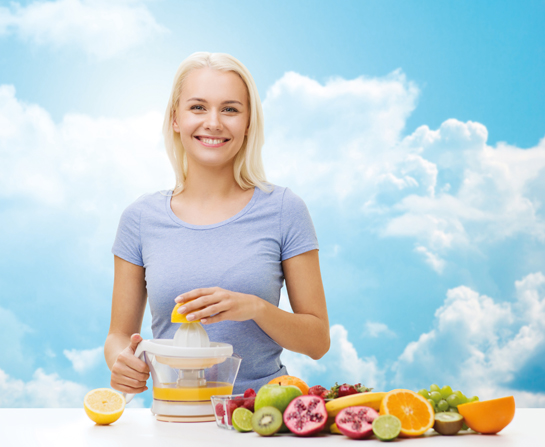Fab or Fad?
May 1, 2022 Return

To think that just several decades ago, juicing was quite a novelty. Back then, juicing was something only associated with overzealous health nuts. But how times have changed! It appears the masses have gotten onto the juicing bandwagon – and said bandwagon seems to be throttling on at full speed.
Everywhere you turn these days, you will come across juice bars offering a variety of juices and smoothies that will leave you lost for choice. Gone are the days when juicing was solely about fruits. Nowadays, you can have ingredients like wheatgrass, whey protein and chia seeds added into your orange juice, to give you that energy boost you need to kick-start your day. Or if you feel like going green, you can opt for a blend of green vegetables. How does a combination of jalapeno (now, that’s a real kick!), kale, spinach, celery and parsley sound? If you are not up for any of the blends listed on the menu, you can even mix and match fruits and vegetables according to your preference. Cool, huh?
What’s the juice on ‘juice’?
Why the juicing craze, though? For one thing, juicing can be a great way to incorporate more fruits and vegetables in the diet of people who do not enjoy eating them. Some claim that the body absorbs nutrients more easily from juices than from eating fruits whole. Then, there are others who believe juicing can aid weight loss, detox, boost immunity and even lower the risk of chronic conditions like cancer and heart disease. These claims have led many to go on ‘juice fasts’ or ‘juice cleanses’ whereby they consume nothing but juice over a certain period of time which can range from a few days to several weeks! Those who testify to the health benefits of these juice cleanses include celebrities such as actress Gwyneth Paltrow and Victoria’s Secret model Rosie Huntington-Whitley.
But is juicing all it is made up to be? Are juice fasts the one-stop health solution that many are raving about? We speak to Dietitian Ms Verona Lee to separate myth from fact.
Juicing: Healthy or Hazardous?
Addressing the juicing fad, Ms Lee explains, “I wouldn’t recommend juicing for detox purposes as there’s actually no scientific evidence which proves its efficacy. Detox is a process which our body performs automatically for 24/7. Our body doesn’t need additional help to detox.”
What about weight loss, then? “Consuming juice with the purpose of losing weight isn’t recommended either. People who go on juice fasts for prolonged periods may lose weight but they are also likely to grow malnourished. Juices are mainly made up of vitamins, mineral and sugar so they end up missing out on other nutrients like protein. In fact, there’s a 2013 study by the Harvard School of Public Health which found that individuals who had three fruit servings weekly experience a 2% reduction in diabetes risk while their peers who had three servings of fruit juice weekly showed an increased diabetes risk of 8%.” Ms Lee cautions, “Juicing fads does our body more harm than good, especially for those with diabetes, kidney disease and heart complications as the sugar levels in fruit juices are too high for them. They should stay away from these fasts.”
Does that mean we should avoid juicing at all costs? She clarifies, “While juicing cleanses are a no-no, juicing is fine as long as you consume a well-balanced diet and ensure that your juices consists of both fruits and vegetables. Remember, the amount of fruits and vegetables in a serving of juice is very crucial. If we add too many fruits, the calorie and sugar content may be excessive. Therefore, a ratio of 3 vegetables to 1 fruit is advised.”
Eat ‘em whole
However, Ms Lee emphasizes the importance of eating fruits whole. “Although, juicing has its benefits (for example, parents can start kids off on juices if they initially refuse to eat fruits and vegetables or cancer patients with chewing difficulties can obtain necessary nutrients from juices), eating fruits and vegetables whole is the best. Juicing removes all the fiber from fruits and vegetables, which is a shame as fiber has a great many uses like aiding bowel movement and controlling cholesterol.”
She suggests eating a minimum of three vegetable servings and two fruit servings daily, as per recommended by the Malaysian Dietary Guidelines. “If you can’t meet this recommended daily intake, you can consider adding more nutrients via juicing. One serving of juice daily is alright. Don’t go overboard. Remember, moderation is key!”
Juice It Up!
Touching on the various juicing methods, Ms Lee explains, “Conventional juicing extracts juice at an extremely high velocity. It usually yields less juice and more pulp. Meanwhile, slow juicing works at a relatively slower speed. Hence, it extracts more juice. But ultimately, you’re still removing pulp (fiber) regardless of whatever juicer you use.”
Also, she says to be mindful of several things when juicing:
- Clean juicers thoroughly. Unclean juicers are good breeding grounds for germs.
- Make a portion of juice which you can finish immediately. Juices left for prolonged periods become unfresh and are susceptible to bacteria growth.
- Finally drink a rainbow, eat a rainbow! Different coloured fruits and vegetables boast different nutrients and antioxidants.

